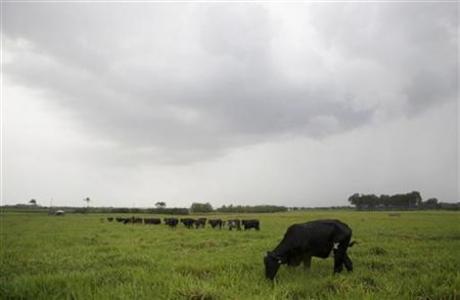Cows Absolved Of Stoking Warming With Nitrous Oxide
Country: OSLO
Author: Alister Doyle

Cows graze in the Embrapa pasture in Porto Velho northern Brazil
November 19, 2009.
Photo: Ricardo Moraes
Grazing by cows or sheep can cut emissions of nitrous oxide -- a powerful greenhouse gas -- in grasslands from China to the United States, according to a study that overturns past belief that farm animals stoke releases.
Adding to understanding of links between agriculture and global warming, the report in Thursday's edition of the journal Nature said livestock can help to limit microbes in the soil that generate the gas, also known as laughing gas.
"It's been generally assumed that if you increase livestock numbers you get a rise in emissions of nitrous oxide. This is not the case," said Klaus Butterbach-Bahl of the Karlsruhe Institute of Technology in Germany who was among the authors.
Laughing gas is one of several heat-trapping gases linked to farm animals and the scientists said there was a need for more study to see how far their findings would affect agriculture's total impact on climate change.
Emissions of the gas account for 6-8 percent of global warming from human activities, making it the third most important greenhouse gas after carbon dioxide and methane, he said. Estimated nitrous oxide emissions from temperate grasslands account for 1-2 percent of the total.
The study, focused on Inner Mongolia in China, said most nitrous oxide emissions from grasslands in places prone to frosts -- including swathes of the United States, Canada, Russia and China -- came in spring when snow melt saturates the soil.
MICROBES
On ungrazed land, snow builds up in winter between grasses, creating an insulating blanket on the ground and aiding growth of microbes that emit nitrous oxide when the spring thaw comes.
On grazed land, more of the microbes get killed by frost since vegetation is sparser and so accumulates less snow.
The study, by scientists in China, Britain and Germany, said emissions were low at other times of the year despite past belief that manure from livestock helps spur releases of nitrous oxide.
Grasslands subject to winter frosts where such gas emissions may have been overestimated make up an area the size of India, or about a third of the world's temperate grasslands that cover about 10 million square kms (3.9 million sq miles).
But the study did not look, for instance, at other damaging climate impacts of livestock. Goats, buffalo, cows and sheep also release heat-trapping methane as they digest food.
The authors said that one way of curbing nitrous oxide emissions was to mow grasslands in the autumn to keep vegetation low and so reduce spring emissions.
"Such simple management practices could have a significant role in reducing nitrous oxide emissions from temperate grasslands on a global scale," they wrote.
But a side-effect of mowing could be the release of more carbon dioxide into the atmosphere. The U.N. panel of climate scientists says global warming may cause more heatwaves, desertification, more powerful storms and rising seas.
© Thomson Reuters 2010 All rights reserved
